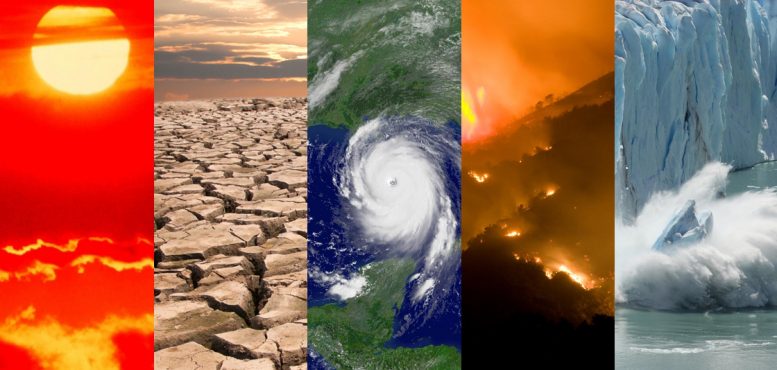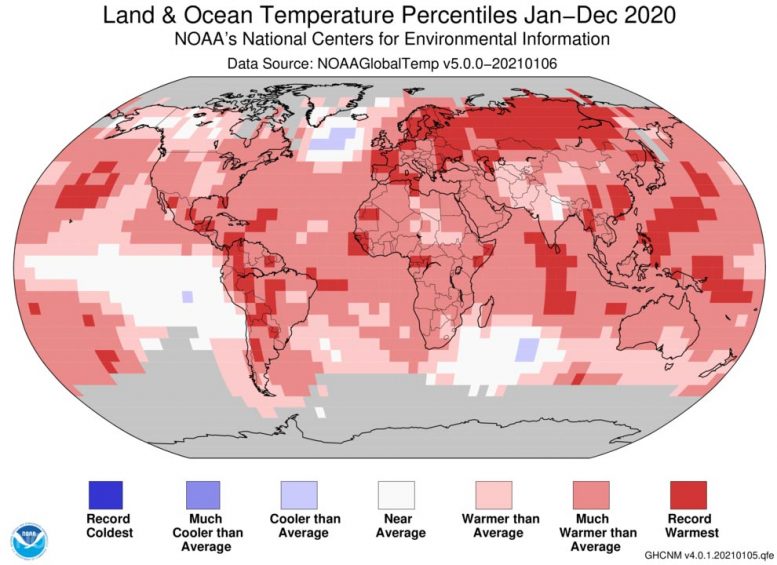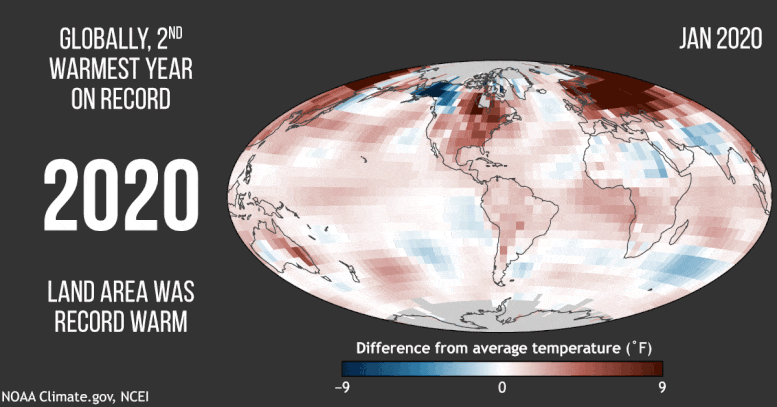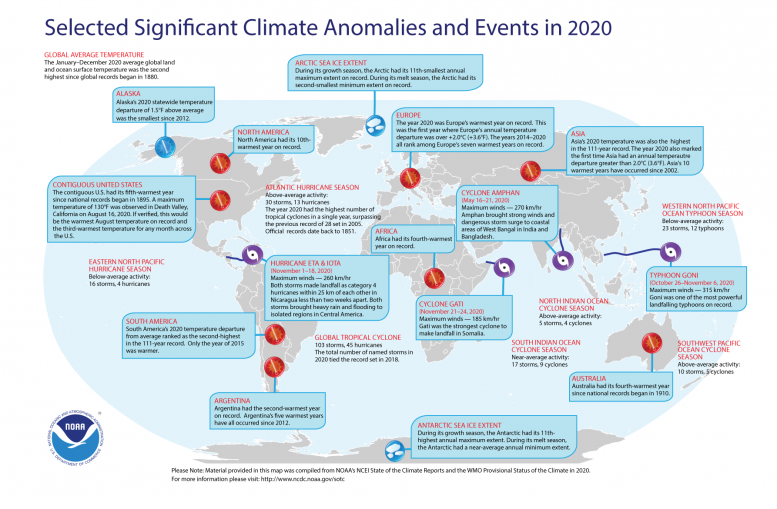
The world’s seven warmest years have all occurred since 2014, with 10 of the warmest years occurring since 2005.
It’s official: 2020 ranks as the second-hottest year on record for the planet, knocking 2019 down to third hottest, according to an analysis by NOAA scientists.
The average land and ocean surface temperature across the globe in 2020 was 1.76 degrees F (0.98 degrees C) above average — just 0.04 degrees F (0.02 degrees C) cooler than the 2016 record.
The Northern Hemisphere saw its hottest year on record at 2.30 degrees F (1.28 degrees C) above the 20th-century average.

A world map plotted with color blocks depicting percentiles of global average land and ocean temperatures for the full year 2020. Color blocks depict increasing warmth, from dark blue (record-coldest area) to dark red (record-warmest area) and spanning areas in between that were “much cooler than average” through “much warmer than average”. Credit: NOAA NCEI
The world’s seven warmest years have all occurred since 2014, with 10 of the warmest years occurring since 2005.
It was also Earth’s 44th consecutive year with global land and ocean temperatures, at least nominally, above the 20th-century average, according to scientists at NOAA’s National Centers for Environmental Information.

A month-by-month animation of temperatures for January through December 2020 compared to the 1981–2010 average, with warm anomalies (difference from the average temperature) of some areas in red and cool anomalies in blue. The final slide shows the 2020 average. Credit: NOAA Climate.gov, using NOAA NCEI data
2020 as ranked by other scientific organizations
NASA scientists, who conducted a separate but similar analysis, have determined that 2020 ties 2016 as the warmest year on record, sharing the first-place spot.
Scientists from Copernicus also have 2020 tying with 2016 as the warmest year on record, while the United Kingdom Met Office ranked 2020 as the second-warmest year on record.
The state of sea ice
The 2020 average annual Arctic sea ice extent (coverage) was approximately 3.93 million square miles and ties 2016 for the smallest on record. The five smallest Arctic annual extents have occurred in the last five years (2016-20).
The annual Antarctic sea ice extent was near average at 4.44 million square miles.

An annotated map of the world plotted with the year’s most significant climate events. Please see the story below as well as the report summary from NOAA NCEI at http://bit.ly/Global202012. Credit: NOAA NCEI
Additional NOAA findings
- Global tropical cyclones in 2020 tied a record: A total of 103 named storms occurred around the world in 2020, tying the record number seen in 2018. The North Atlantic played an unusually large role in the global activity in 2020, accounting for about 30% of the global accumulated cyclone energy (ACE) and named storms — which is more than twice its usual share.
- Oceans were exceptionally warm: The 2020 annual global sea-surface temperature was the third highest on record at 1.37 degrees F (0.76 degrees C) above the 20th-century average — only 2016 and 2019 were warmer. Record-high sea surface temperatures were observed across parts of the Atlantic, Indian, and Pacific oceans.
- Northern Hemisphere saw sparse snow cover: The average annual Northern Hemisphere snow cover for 2020 was 9.31 million square miles. This was the fourth-smallest annual snow cover in the 1967–2020 record.
- December 2020: Last month’s average temperature across global land and ocean surfaces was 1.40 degrees F (0.78 degrees C) above the 20th-century average, making it the eighth-warmest December in the 1880–2020 record.









Why should this surprise anyone “The world’s seven-warmest years have all occurred since 2014, with 10 of the warmest years occurring since 2005.”. If we are in a warm phase, then one would expect the warmest years ever to all sit in a close group. You could compare that to being on the top of a mountain where all the land around you would also be close to the peak of the mountain.
Yes, another non sequitur from NOAA, intended to panic people who don’t think about the things they read. One might ask, “Why wasn’t a new record set instead of it just being an ‘also ran?'”
“Warmest year” needs a little context. Since when? The era of reasonably accurate global temperature calculation only began in 1979 with the advent of satellite measurement. This coincides with the beginning of a warm-up. From the ’40s to the ’70s, the planet cooled — so much so, scientists were predicting a catastrophic ice age was imminent. .. At any rate, it certainly has been warmer than now several times during the Quaternary. Not sure what all the hand-waving is about.